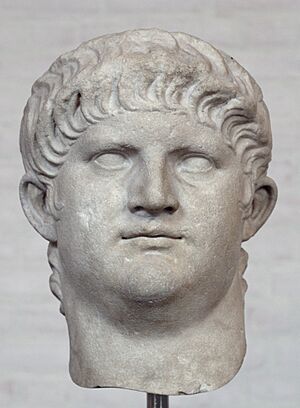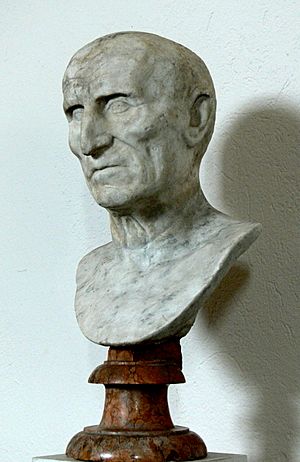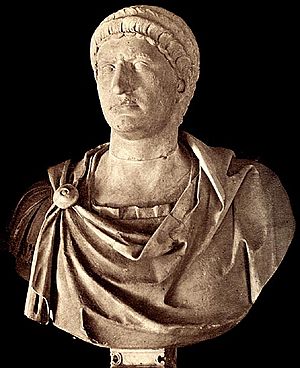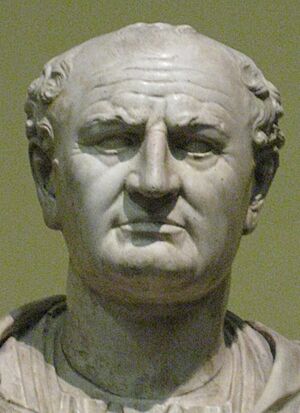Year of the Four Emperors facts for kids
The Year of the Four Emperors was a special time in the history of the Roman Empire. It happened in the year AD 69, when four different emperors ruled one after another in a very short time! These four emperors were Galba, Otho, Vitellius, and Vespasian.
When Emperor Nero died in AD 68, it led to a short but intense civil war. This was the first Roman civil war since Mark Antony's death many years before. From June 68 to December 69, Rome saw Galba, Otho, and Vitellius rise and fall. Finally, Vespasian became emperor, starting a new family line of rulers called the Flavian Dynasty.
This period showed how much political trouble the Roman Empire could face. The fighting and confusion caused by this civil war had big effects. For example, the Batavian rebellion started, and the Jewish Revolt was already happening.
Contents
How the Emperors Changed
From Nero to Galba
By June of AD 68, the Roman Senate (a powerful group of leaders) decided to get rid of Nero. They declared him an enemy of the public and named Galba as the new emperor. The Praetorian Guard (the emperor's special bodyguards) were paid to turn against Nero. Nero then took his own life. Galba was accepted as emperor and entered Rome with his armies.
But Galba didn't stay popular for long. As he marched to Rome, he either destroyed towns or made them pay huge fines if they didn't support him right away. In Rome, Galba canceled many of Nero's changes, which upset many important people. The army was also unhappy. Galba had promised rewards to the soldiers who helped him, but he refused to pay them once he was safe in Rome. The Roman treasury (the government's money) was low after Nero's spending, but Galba handled it poorly.
Like Nero, Galba worried about people plotting against him. He had many senators and important citizens put to death without a proper trial. Also, at the start of AD 69, on January 1, the armies in Germania Inferior (a Roman province) refused to promise loyalty to Galba. The very next day, these armies declared Vitellius, their governor, as emperor.
Marcus Salvius Otho then paid the Praetorian Guard, who were already very unhappy with Galba. They joined Otho's side. When Galba heard about this sudden takeover, he went into the streets to try and calm things down. This was a mistake, as he couldn't find anyone to support him. Soon after, the Praetorian Guard killed him in the Forum.
From Otho to Vitellius
The Senate quickly recognized Otho as emperor that same day. People felt relieved about the new emperor. Even though Otho was ambitious and wanted more power, he wasn't known for being cruel. People hoped he would be a fair ruler. However, trouble was coming from Germany: Vitellius and his armies were marching towards Italy.
Vitellius had some of the best and most experienced armies in the empire. These strong forces were his main way to gain power. Otho didn't want another civil war. He sent messengers to Vitellius, suggesting peace and even inviting Vitellius to become his son-in-law. But it was too late for talking. Vitellius's generals already had half of his army moving towards Italy. After some smaller battles, Otho's forces were defeated at the Battle of Bedriacum. Instead of running away and trying to fight back, Otho chose to end the fighting by taking his own life. He had been emperor for just over three months.
From Vitellius to Vespasian
When news of Otho's death reached them, the Senate recognized Vitellius as emperor. With this approval, Vitellius headed for Rome. But he faced problems from the very beginning of his rule. The people of Rome became very doubtful when Vitellius chose a day that Romans believed was unlucky to accept the important role of Pontifex Maximus (chief priest).
Events seemed to prove them right. With the throne now secure, Vitellius spent his time on many feasts, banquets, and victory parades. This spending quickly brought the imperial treasury close to having no money left. Debts grew fast, and people who had lent money started demanding it back.
Vitellius showed his violent side by ordering the torture and killing of anyone who dared to ask for their money. Vitellius even killed citizens who named him as their heir (someone who would get their money after they died), often along with anyone else who was supposed to inherit. He also hunted down any possible rivals, inviting them to the palace with promises of power, only to have them killed.
Vespasian had been given a special job by Nero in AD 67. He was sent to Judaea to stop the Great Jewish Revolt. He gained the support of Gaius Licinius Mucianus, the governor of Syria. A strong army made up of soldiers from Judaea and Syria marched on Rome under Mucianus's command. Vespasian himself went to Alexandria, where he was declared Emperor on July 1. This gave him control of the important grain supplies from Egypt. Vespasian's son Titus stayed in Judaea to continue fighting the Jewish rebellion. Before the eastern armies could reach Rome, the armies from the Danube River provinces of Raetia and Moesia also declared Vespasian emperor in August. Led by Marcus Antonius Primus, they invaded Italy. In October, Primus's forces won a huge victory over Vitellius's army at the Second Battle of Bedriacum.
Surrounded by enemies, Vitellius made a last effort to win the city's support. He gave out bribes and promised power where needed. The Danube army was now very close to Rome. Vitellius went into hiding and got ready to run away, but he decided to visit the palace one last time. There, Vespasian's men caught him and killed him. As they took control of the capital, they accidentally burned down the temple of Jupiter.
The Senate recognized Vespasian as emperor the next day. It was December 21, AD 69, the same year that had started with Galba on the throne.
Timeline of Events
AD 68
- April – Servius Sulpicius Galba, governor of Hispania Tarraconensis, and Vindex, governor of Gallia Lugdunensis, start a rebellion against Nero.
- May – The armies along the Rhine River defeat and kill Vindex in Gaul.
- June – Nero is declared a public enemy by the Senate (June 8) and takes his own life (June 9); Galba is recognized as emperor.
- November – Vitellius is named governor of Germania Inferior.
AD 69
- January 1 – The Rhine armies refuse to promise loyalty to Galba.
- January 2 – Vitellius is declared emperor by the Rhine armies.
- January 15 – Galba is killed by the Praetorian Guard; on the same day, the Senate recognizes Otho as emperor.
- April 14 – Vitellius defeats Otho.
- April 16 – Otho takes his own life; Vitellius is recognized as emperor.
- July 1 – Vespasian, commander of the Roman army in Judaea, is declared emperor by the armies in Egypt under Tiberius Julius Alexander.
- August – The armies along the Danube River announce their support for Vespasian (who is in Syria) and invade Italy in September on his behalf.
- October – The Danube army defeats Vitellius, and Vespasian takes control of Egypt.
- December 20 – Vitellius is killed by soldiers in the Imperial Palace.
- December 21 – Vespasian is recognized as emperor.
Related Pages
- Tacitus, Histories
- Year of the Five Emperors (AD 193)
- Year of the Six Emperors (AD 238)
See also
 In Spanish: Año de los cuatro emperadores para niños
In Spanish: Año de los cuatro emperadores para niños






